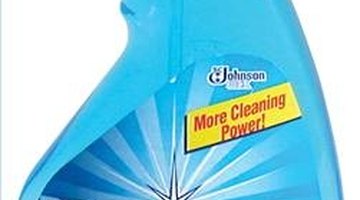What Chemicals Are in Windex?
Table of Contents
Windex is a commercial product used for cleaning glass and other surfaces. Known for its signature blue color and ammonia like fragrance, the popularity of the product led to its brand name being commonly used to refer to any brand of window cleaner.

Invented in 1933, the original product was highly combustible and had to be completely reformulated. Since then the product has undergone a number of 'improvements' with the current formula being a more environmentally friendly version of its predecessors.
Old Formula
In 1933, Harry R. Drackett invented the Windex window cleaner. The original product was a mixture of highly flammable solvents that had to be sold in metal cans. At the end of World War II, surfactants were introduced to the population at large. A surfactant is a compound that can be dissolved in both organic solvents and water, allowing the formula to be 'watered down' during the reformulation.
One old Windex formula contained water, isopropyl alcohol (a highly flammable solvent), ethylene glycol (another solvent, not quite as effective), sodium laurel sulfate (a surfactant which attracts dirt, keeping it from re-depositing once removed), and ammonia (a strong base used to dissolve organic compounds- such as grease). This formula was cheap to manufacture and safe to use, allowing the company to switch to the more attractive clear bottles with convenient spray attachments.
New Formula
Windex is not longer just a glass cleaner. Now there's a Windex product specifically designed to clean every surface of your home. But the old blue bottle is still the first thing people think of when you say Windex, and for good reason. The chemicals in Windex work to clean glass without leaving visible streaks and safely clean a variety of surfaces. Popular as Windex is, the old, reliable formula has been adjusted to make it more environmentally-friendly. According to the Materials Safety and Data sheets for original blue Windex, the new environmentally friendly formula contains the following ingredients: Isopropanol, 2-Butoxyethanol, Ethylene glycol n-hexyl ether, water, fragrance and blue dye.
Isopropanol
Isopropanol or isopropyl alcohol has always been a major component of the Windex chemical formula. This highly flammable liquid is cheap, widely available and relatively non-toxic. It dissolves a wide range of compounds and dries quickly without leaving streaks behind. It's good for removing everything from glue residue to fingerprints.
2-Butoxyethanol
Though mainly used to remove paint, 2-Butoxyethanol is found in a wide variety of cleaners. This colorless liquid has a sweet aroma and is valued for its ability to dissolve things such as soap scum, ink, grease, and oil. Though a relatively new component of the Windex chemical formula, it has been popular in whiteboard cleaners, dry cleaning solutions and oil spill dispersants for years.
Ethylene glycol n-hexyl ether
Ethylene glycol has been part of the Windex formula for quite some time. This chemical functions as a solvent, a surfactant, and a detergent. This means it dissolves dirt and grime and helps to keep it from setting back on the glass once it has been broken up.
Water
Water is known as the universal solvent, it is very effective at dissolving many types of things. The addition of water to the chemical formula was critical to the success of Windex as it made the product less volatile and safer and easier to use.
Warning
While the MSDS gives Windex a low overall hazard rating, it can cause minor irritation to your eyes and respiratory system. If the product comes into contact with your eyes, flush immediately with water. If the smell is bothering you, open a window or go outside for some fresh air. If accidental ingestion occurs, call the Poison Control Center of dial 911 for immediate assistance.
Resources
Writer Bio
Lisa Parris is a writer and former features editor of "The Caldwell County News." Her work has also appeared in the "Journal of Comparative Parasitology," "The Monterey County Herald" and "The Richmond Daily News." In 2012, Parris was honored with awards from the Missouri Press Association for best feature story, best feature series and best humor series.
More Articles



